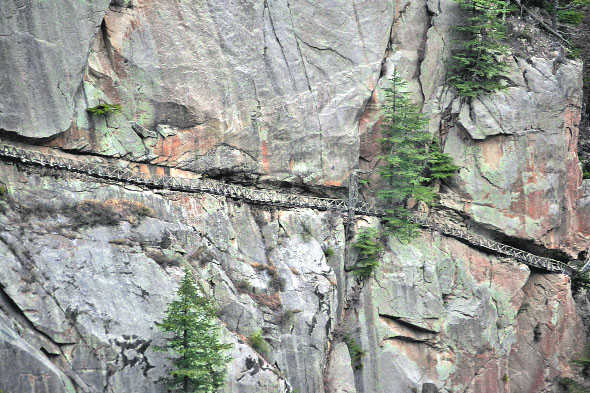Ajay Ramola
Tribune News Service
Mussoorie, May 22
Uttarkashi district, besides being a famous centre of religious learning of the Hindus since ancient times, was also known for the trade route to Tibet. The first big market ‘Bada Haat’ used by Indian traders for selling Chinese goods was established here. The trade from the district was completely stopped after the war with China in 1962 and was not resumed in 1992 when it was restarted from the Lipulekh pass.
A big trade market fair was held at ‘Bada Haat’ every year where Bhotia tribesmen from the district brought different kinds of goods from Tibet to be sold during the fair held in January. The Bhotia tribes lived in villages of the Jadung and Nelong valleys. They used to trade at ‘Bada Haat’ in Uttarkashi and exchange goods according to their requirements. The festival is still held in Uttarkashi but the trade with Tibet has discontinued since the Chinese aggression in 1962.
The remnants of the border trade can be seen in the expansive Nelong valley, a cold desert like landscape similar to Ladakh situated at an altitude of around 11,000 feet. It falls under the Gangotri National Park in Uttarkashi district. Many structures related to the old trade route, including a wooden bridge known as Gartang Galion and the Lal Devta temple, where the trading Bhotia tribe used to offer prayers before crossing over to Tibet, still exist in the area.
The infrastructure that was developed in those days suggests that the trade with Tibet was the mainstay of the local economy, say old residents of Uttarkashi.
Sheep and goats and products made out of their skins such as socks and warm clothes were an essential part of the trade.
Agricultural implements, tobacco, snuff, blankets, tea, coffee, barely, rice, spices, copper products, indigenous medicines, salt etc were traded by Bhotia traders on the basis of the barter system. The women of this tribe were good weavers of carpets, blankets and woollen clothes and were known to sell clothes made of yak wool and skins.
The Bhotias with Mongoloid features are good climbers and can reach high altitudes with ease. Their keen sense of direction helps them in the trade considering the difficult Himalayan terrain. The Bhotias are found in the districts of Almora, Chamoli, Pithoragarh and Uttarkashi and the trade with China flourished through the routes in these districts.
Rang Bhotias are subdivided into Byanse, Darmi and Chaudensi. Rang and Johari Bhotias belong to Pithoragarh district while Tolcha and Marcha Bhotias are from Chamoli district. Jad Bhotias, who mostly lived in Uttarkashi district, used to go to Tibet for the trade through passes in the Jadung and Nelong valleys. Besides trade, they had cultural and religious links with Tibet.
Jad Bhotias involved in the trade followed the main Jad river upstream passing through two camping spots of grazers, namely Hilding and then Do-Sumdo. They then reached the Thaga pass that forms one of the important corners of the Bhot Pradesh triangle. The traders following the path right from Do-Sumdo via Tirpani reached the Himalayan border at the Jelu Khaga pass. From here, they crossed into Tibet and reached Chhabrang Zong, which was the first Tibetan trading centre on the route. Another centre Tholing is 10 km northeast and serves as an important trade junction from where several other trade routes lead to western Tibet.
The places such as Nelong, Naga, Neela Pani and Sonam in the district developed into flourishing trading stopovers. The ban on the trade with Tibet had badly affected the local economy, especially of the Bhotia community. The trade with China from Uttarkashi completely stopped though it is continuing from Pithoragarh in the Kumaon region.
Uttarkashi residents say neither the state government nor the Union government has made any efforts to resume the trade with China from the district. On the contrary, the government has restricted the movement of Indian and foreign tourists by introducing an inner line permit clause. Indian tourists have to seek several permissions to enter the Nelong Valley while foreign tourists cannot go there.
Ajai Puri, president of the Uttarkashi Hotel Association, says it is preposterous that while we are inviting Chinese entrepreneurs to invest under the Make in India programme, the Central government has not worked towards resuming the trade with China through the district and not allowed the movement of people.
He says the trading community demands opening of trade routes to Tibet and mainland China so that the nation and local people could benefit.
Unlock Exclusive Insights with The Tribune Premium
Take your experience further with Premium access.
Thought-provoking Opinions, Expert Analysis, In-depth Insights and other Member Only Benefits
Already a Member? Sign In Now










